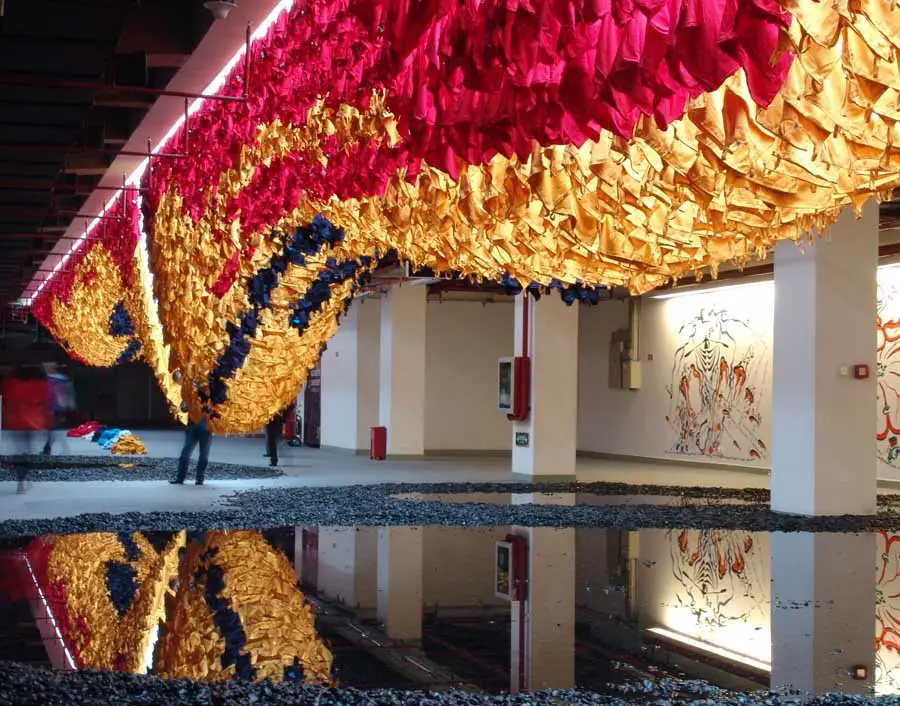Shenzhen Hong Kong Biennale Installation, SZHK Design, Ball Nogues Studio Project
SZHK Biennale Project, China by Ball Nogues Studio
Shenzhen Hong Kong Biennale Installation design by Ball Nogues Studio
4 Feb 2010
SZHK Biennale Design
Built to Wear
A new installation by Ball Nogues Studio for the 2009 Shenzhen Hong Kong Biennale of Urbanism. Sponsored by American Apparel.
Temporary spatial installations within urban cultures are a rapidly evolving phenomenon. Unlike “permanent” buildings, these structures nimbly respond to the accelerated temporality of cities on the move like Shenzhen and Hong Kong. Increasingly they provide the urban spectacles that “signature” buildings aim to deliver.
SZHK Biennale Installation by Ball Nogues Studio:
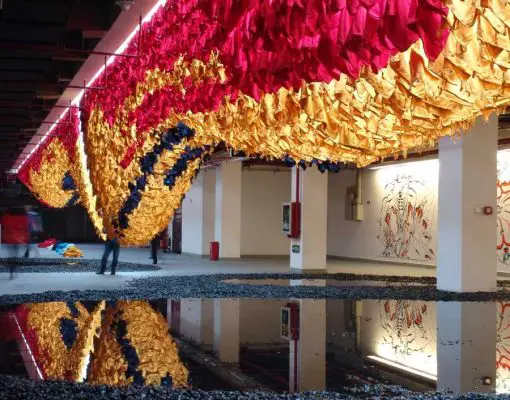
photo : Benjamin Ball
Like never before, cities are adorned with provisional environments and architecturally scaled events. This situation has been further emboldened by the financial meltdown in 2008 as investors look to spend money on big urban spectacles without the financial commitment of making buildings. Within this economic outlook, the disposable plates of architecture are better investments than a collection of fine tableware. However, an important question looms when cleaning up after the meal: can the plate be composted or should it be colored with crayon and reused as a party decoration?
SZHK Biennale Installation by Ball Nogues Studio:
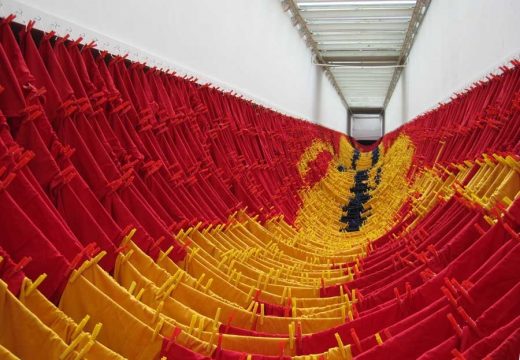
photo : Benjamin Ball
Built to Wear, constructed for the 2009 Shenzhen Hong Kong Biennale of Urbanism will be on view from December 5th through January 23 2010 in the underground exhibition space at the Shenzhen Civic Square. Invoking the theme of the exhibition – City Mobilization – the construction of the installation activated collaboration between Ball Nogues Studio, American Apparel, the Biennale organizers and a group of 30 volunteers from Shenzhen. This hanging architecturally scaled structure is comprised of 10,000 items of clothing manufactured by American Apparel – operator of the largest garment factory in the United States. Each garment serves the dual role of building component and individual article of clothing.
SZHK Biennale Installation by Ball Nogues Studio:
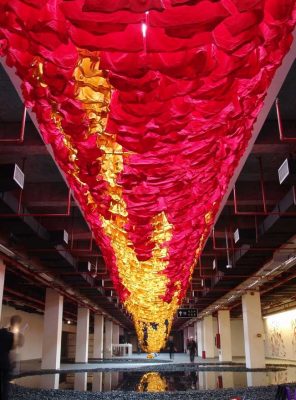
photo : Benjamin Ball
Over the course of the Biennale, the installation will be dismantled and the T-shirts, muscles shirts, spaghetti tank tops, baby dresses, bikinis and g-strings comprising it will be dispersed to visitors. At a time when most US garment production has moved offshore, Built to Wear invites viewers to contemplate the relocation of manufacturing from the developed world to emerging economic powers like China while reconsidering notions of material lifecycle in architecturally scaled structures. By using a coveted consumer good – the garment – as its basic building block the project expands and critiques notions of “green’ architecture while activating public space through consumption.
As a visual concept, the installation will serve as a symbolic gesture of sustainability and a poetic reminder that the buildings in our cities are impermanent: frozen moments in the flow of products through the tributaries of global exchange. Outside of its environmental commentary, the project dramatically recontextualizes the clothing item – a symbol of mass consumerism – into an alternative gesture of hope.
SZHK Biennale Installation by Ball Nogues Studio:
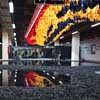
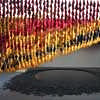
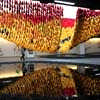
photos : Bai Xiaoci
SZHK Biennale Built to Wear Design – Team Information
Principals in Charge: Gaston Nogues, Benjamin Ball
Project Coordinators: Qi Yue Yue, Brianna Gorton, Ken Tan
Project Team Los Angeles: Norma Silva, Patrick LaTona, Jonathan Kitchens, Ayodh Kamath, Rochelle Gomez
Project Team Shenzhen: Li Huan, Chen Xin, Wang Guo Xian, Wang Yi Le, Wang Dan Chun, Li Ying Xin, Huang Zhu Yan, Lai Ruo Yin, Luo Jia Ye, Ke Ya Wen, Wang Hai Xuan, Liang Ting Ting, Lin Ting, Chen Su Hui, Zhang Zhi Peng, Yang Gao Bin, Xu Xiao Guang, Zheng Jia Wei, Pan Shan Shan, Rong Na Na, Liu Xi, Liu Jia Qiong, Zhuang Jie Rui, Lin Chao, Xu Yi Jing, Zeng Xiao Mi, Daniel Fernándezpascual, José Esparza, Custom Software: Pylon Technical
Curator: Beatrice Galilee
SZHK Biennale
Statement about City Mobilization by Chief Curator Ou Ning
The Biennale phenomenon originated in Venice a hundred years ago. An evolution of the world expositions popular in the 19th century, it is a form closely associated with the rise of the nation-states and their need to claim sovereignty. The Venice Biennale – a living fossil of the history of the biennale system – maintained the tradition of organizing content according to nationality, a feature which has resulted in the establishment of “national pavilions”. In the past hundred years, radical changes within human history and society have helped to propagate biennales; and as it stands now, there are more than three hundred of them taking place all over the world. It is worth noting, however, that with the end of the cold-war era and the integration of the global economy, the concept of “nation-state” has itself been taking a less significant role.
Biennales, in turn, have become less concerned with national identity and more closely resemble competitions between individual cities. Cities around the world swarm to the biennale model, creating cultural, artistic and other spectacles to attract multinational capital and visitors. The resulting boom of the travel industry has also triggered the regeneration of cities in the post-industrial era and, in Saskia Sassen’s terms, has turned them into “Global Cities” – nodes on a chain of global economy, financial markets and culture.
Is this the only reason behind the worldwide prosperity of biennales? Are biennales the “magic bullet” for a city’s regeneration? Is there a new possibility for this 100-year-old model? For the Shenzhen & Hong Kong Biennale of Architecture and Urbanism (hereafter “SZHKB”) – a newcomer to the scene – these questions are inevitable.
SZHK Biennale Installation by Ball Nogues Studio:
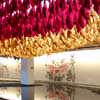
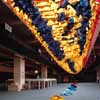
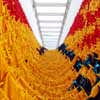
photos : Benjamin Ball
Just like its older sibling – the museum system – the biennale is not without its own share of problems. To begin with, it has become a game of power within certain professional circles and a repetitive machine of production and marketing. With hundreds of biennales around the world, only about a thousand curators and artists can be considered active players in the scene. Faces you see in one biennale are likely to be found in another one the following year, and it is practically possible to compile a list of no more than 10,000 common players amongst frequently jet-setting visitors.
Therefore, the measure of success for a biennale organizer lies in the ability to engage this finite group of people. Second, biennales have long situated themselves high on their horse, taking a top-down approach towards the public. They deem the audience as those who need to be educated, rather than as participants who deserve a non-hierarchical, interactive relationship with both the organizers and the artists.
Although public education programs have a significant presence in the biennale and museum system nowadays, this has become more akin to a gesture of accessibility and a symbolic giving back to the tax payers – aka the general public. The whole concept of “education” however, implies an underestimation of the public’s ability to interpret and actively participate in the exhibited works.
As a young biennale with only two previous installments (in 2005 and 2007, respectively), SZHKB has invented an innovative, dual-city mode of operation which may be summarized as “Two Cities, One Biennale”. To focus not only on architecture but also urbanism means to have a very open vision in terms of the biennale’s content; practically any topic, opinion and creation related to “city” can be considered. As the inhabitants and users of the city, the residents themselves should be able to have their voices heard, and SZHKB is keen on engaging them, either as participant or audience.
A “Citizen Participation” section was launched in the first SZHKB for the purpose of inviting and discovering grass-roots creativity by the citizens themselves, who are encouraged to propose works to be exhibited in the same space and exhibition framework with professional architects, urban researchers and artists. This groundbreaking approach has torn down the professional barrier set up by traditional biennales, thus lending a democratic tinge to the entire SZHKB exhibition and enterprise.
In other words, there is the possibility for another kind of biennale besides the one reliant upon visual spectacle. A biennale can be a meeting hall, or social action, or even a political event. It can be a city-wide carnival, an entertainment gala that engages all citizens. It doesn’t have to happen in a certain museum or be limited to one place, rather, it can turn the whole city into an exhibition venue, or even develop other cities into sub-venues. It does not simply attract people from around the world to Shenzhen and Hong Kong, it helps to organize the citizens of Shenzhen to visit other participating cities. The key to all these propositions lies in one word: mobilization.
The 2009 SZHKB is organized around the theme of “City Mobilization”. The aim is to test the possibility of large-scale, effective social mobilization in a time that lacks centralized force, spiritual solidarity and practical organization. The design of contemporary cities are not only about the functional planning of streets and blocks and the arrangement of buildings, rather it is about the organization and coordination of the people living in and events occurring inside these cities and spaces, as well as the elaborate distribution of their interests. Urban designers and architects have long been focusing on the building of physical space, and are seldom attentive to the social structures, community interests and political realities behind these cities and buildings.
Eventually, they succumb to the interests of state power or become subsumed by the profit-oriented capitalist machinery, paying little heed to the sustainability and the human dimension of their creations. For the third SZHKB this year, we aim to mobilize urban designers and architects to reconsider their social identities and professional roles, moreover, we also want to mobilize artists, authors, musicians, filmmakers, thinkers, social activists, politicians and citizens to offer their intellectual support. Let us revitalize the spiritual foundation of our society in a spiritually fragile time, and build a foundation, though rooted in the city, that is poised to benefit the countryside and territories beyond.
A biennale should not simply be an exhibition for the high and mighty, nor should it be only an incubator of new economic achievements. Apart from being the business card of a city, it should attempt to regain intellectual criticality, invoke the public’s desire for action, and take up the responsibility of advancing social progress. Shenzhen and Hong Kong, the twin cities of the Pearl River Delta at the southern tip of China, are well known for being the engine rooms of China’s “Open Door Policy” reforms some thirty years ago. With its proximity to Hong Kong, Shenzhen has been the cornerstone of economic experiments that have contributed significantly to China’s current astonishing social transformation.
A biennale co-hosted by two such cities was born with a kind of audacity that defies accepted boundaries, a kind of chutzpah that challenges and provokes. We hereby sincerely invite you to Shenzhen and Hong Kong to witness the next page in the history of these two remarkable cities, and to take part in our enterprise to reinvent the shared values of our time. Let’s get mobilized, let’s be cutting-edge, provocative and critical. Together, we will usher in a warm and sunny winter in South China this year.
SZHK Biennale Installation 2009 Bug Dome by WEAK!
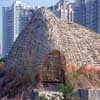
photo © Marco Casagrande
SZHK Biennale Installation images / information from Ball Nogues Studio
Location: Shenzhen, Eastern Asia
Shenzhen Architecture Designs
Shenzhen Architectural Designs
Shenzhen Hong Kong Biennale 2011/12
Shenzhen Architecture Biennale 2013
Bi-City Biennale of Urbanism\Architecture in Shenzhen
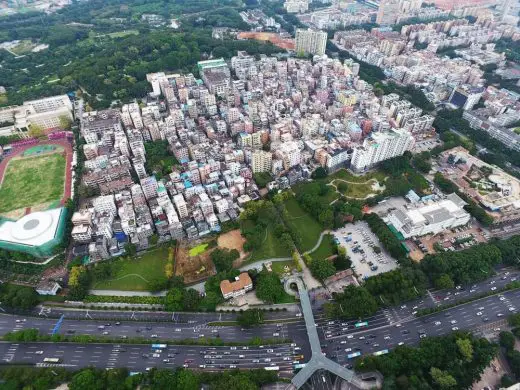
Bi-City Biennale of Urbanism\Architecture: UABB
Bi-City Biennale of Urbanism\Architecture: UABB
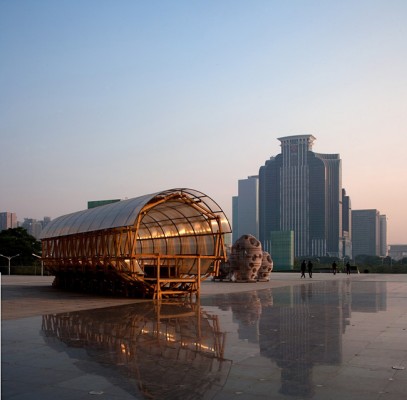
picture courtesy Shenzhen & Hong Kong Bi-City Biennale of UrbanismArchitecture
Shenzhen Architecture Biennale
Key Shenzhen Design
Shenzhen 4 in 1 Towers
MVRDV

picture © MVRDV
Shenzhen 4 in 1 Towers
Hong Kong Architecture Designs – chronological list
Hong Kong Architecture Tours by e-architect
Comments / photos for the SZHK Biennale Installation Architecture page welcome

